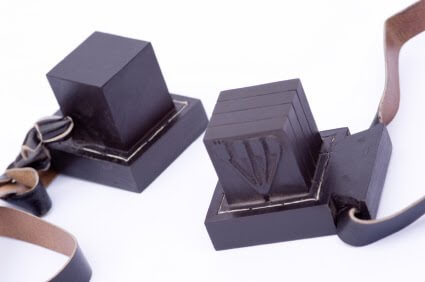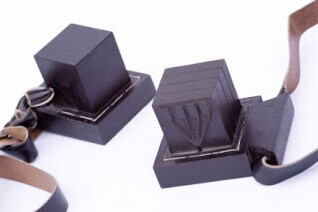
“And you shall bind them [the words that I command you today] for a sign upon your arm, and they shall be for frontlets between your eyes… (Deuteronomy 6:8)”
The above verse refers to the mitzvah of tefillin (although the word tefillin does not actually appear anywhere in the text of the Torah). While repeated four times in the Torah, this very limited text is the way the mitzvah is described. Our entire understanding of tefillin’s physical form comes from the oral law, passed down from Moses to Joshua and onto the elders and the sages.
Tefillin are small black leather boxes that are strapped to the arm (tefillin shel yad) and to the head (tefillin shel rosh). The box of the tefillin shel yad (arm) has a single compartment in which is placed a single scroll containing the four Torah passages that refer to this mitzvah: Exodus 13:1-10, Exodus 13:11-16, Deuteronomy 6:4-9 and Deuteronomy 11:13-21. The box of the tefillin shel rosh has four separate compartments formed from one piece of leather–each of the four Biblical sections is written on a separate scroll and placed in its own individual compartment.
In order to be kosher:
1) The scrolls with the Torah verses must be written on parchment with ink, bound by the hair of a kosher animal and wrapped in a strip of cloth.
2) The black boxes (made from the hides of kosher animals) and their stitches (sewn with the sinew of a kosher animal) must be perfectly square with an opening made for the straps. The tefillin shel rosh must have the letter shin embossed on both its right and left sides.
3) The straps must be colored black.
The common translation of tefillin is “phylacteries,” which is a Greek word meaning amulet.
To see how tefillin are prepared, visit a virtual tour of a tefillin factory.
Related Posts
Exodus
To prepare for Passover, read the first few chapters of the Book of Exodus.
0 Comments1 Minute
Where to Wear Tefillin
While Jewish Treats has previously discussed the requirements for…
0 Comments2 Minutes
Where To Wear Tefillin
While Jewish Treats has previously discussed the requirements for kosher tefillin…
1 Comment2 Minutes
 Print This Page
Print This Page